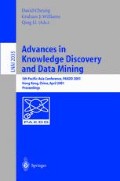Abstract
A Knowledge Acquisition method “Ripple Down Rules” can directly acquire and encode knowledge from human experts. It is an incremental acquisition method and each new piece of knowledge is added as an exception to the existing knowledge base. This knowledge base takes the form of a binary tree. There is another type of knowledge acquisition method that learns directly from data. Induction of decision tree is one such representative example. Noting that more data are stored in the database in this digital era, use of both expertise of humans and these stored data becomes even more important. In this paper, we attempt to integrate inductive learning and knowledge acquisition. We show that using the minimum description length principle, the knowledge base of Ripple Down Rules is automatically and incrementally constructed from data and thus, making it possible to switch between manual acquisition by a human expert and automatic induction from data at any point of knowledge acquisition. Experiments are carefully designed and tested to verify that the proposed method indeed works for many data sets having different natures.
Access this chapter
Tax calculation will be finalised at checkout
Purchases are for personal use only
Preview
Unable to display preview. Download preview PDF.
References
C.L. Blake and C.J. Merz. UCI repository of machine learning databases, 1998. http://www.ics.uci.edu/mlearn/MLRepository.html.
P. Compton, K. Horn, J.R. Quinlan, and L. Lazarus. Maintaining an Expert System, pages 366–385. Addison Wesley, 1989.
B.R. Gaines. An ounce of knowledge is worth a ton of data: Quantiative studies of the trade-off between expertise and data based on statistically well-founded empirical induction. In Proc. of the 6th International Workshop on Machine Learning, pages 156–159, San Mateo, California, June 1989. Morgan Kaufmann.
B.R. Gaines. The Trade-Off Between Knowledge and Data In Knowledge Acquisition, chapter 29, pages 491–505. MIT Press, Cambridge, Mass, 1991.
B.R. Gaines and P. Compton. Induction of ripple-down rules. In Proc. of the 5th Australian Joint Conference on Artificial Intelligence, pages 349–354, Singapore, 1992. World Scientific.
B.R. Gaines and P. Compton. Induction of ripple-down rules applied to modeling large databases. Journal of Intelligent Information Systems, 5(2):211–228, 1995.
D.K. Gary and J.H. Trevor. Optimal network construction by minimum description length. Neural Computation, pages 210–212, 1993.
B.H. Kang. Validating Knowledge Acquisition: Multiple Classification Ripple Down Rules. PhD thesis, Dept. of Electrical Engineering, University of New South Wales, 1996.
K. Morik, S. Wrobel, J. Kietz, and W. Emde, editors. Knowledge Acquisition and Machine Learning: Theory, Methods, and Applications. Academic Press, 1993.
J.R. Quinlan, editor. C4.5: Programs for Machine Learning. Morgan Kaufmann, 1993.
J.R. Quinlan and R.L. Rivest. Inferring decision trees using the minimum description length principle. Information and Computation pages 227–248, 1989.
J. Rissanen. Modeling by shortest data description. Automatica, pages 465–471, 1978.
J. Suzuki. A construction of bayesian networks from databases on an mdl principle. In Proc. of the 9th Conference on Uncertainty in Artificial Intelligence, 1993.
The University of Toronto. Data for evaluating learning valid experiments, 1998. http://www.cs.utoronto.ca/~delve/data/datasets.html.
S. Wrobel, editor. Concept Formation and Knowledge Revision. Kluwer Academic Publishers, 1994.
Author information
Authors and Affiliations
Editor information
Editors and Affiliations
Rights and permissions
Copyright information
© 2001 Springer-Verlag Berlin Heidelberg
About this paper
Cite this paper
Wada, T., Motoda, H., Washio, T. (2001). Knowledge Acquisition from Both Human Expert and Data. In: Cheung, D., Williams, G.J., Li, Q. (eds) Advances in Knowledge Discovery and Data Mining. PAKDD 2001. Lecture Notes in Computer Science(), vol 2035. Springer, Berlin, Heidelberg. https://doi.org/10.1007/3-540-45357-1_58
Download citation
DOI: https://doi.org/10.1007/3-540-45357-1_58
Published:
Publisher Name: Springer, Berlin, Heidelberg
Print ISBN: 978-3-540-41910-5
Online ISBN: 978-3-540-45357-4
eBook Packages: Springer Book Archive

